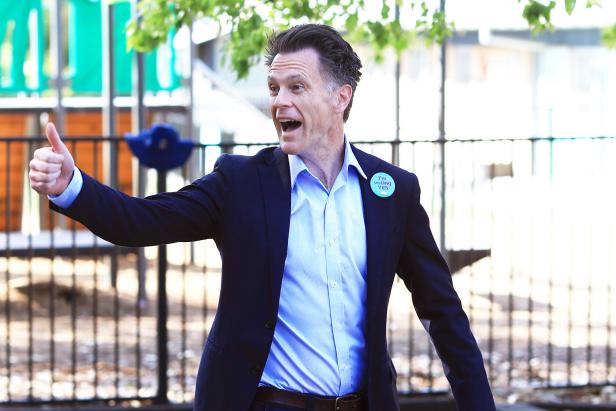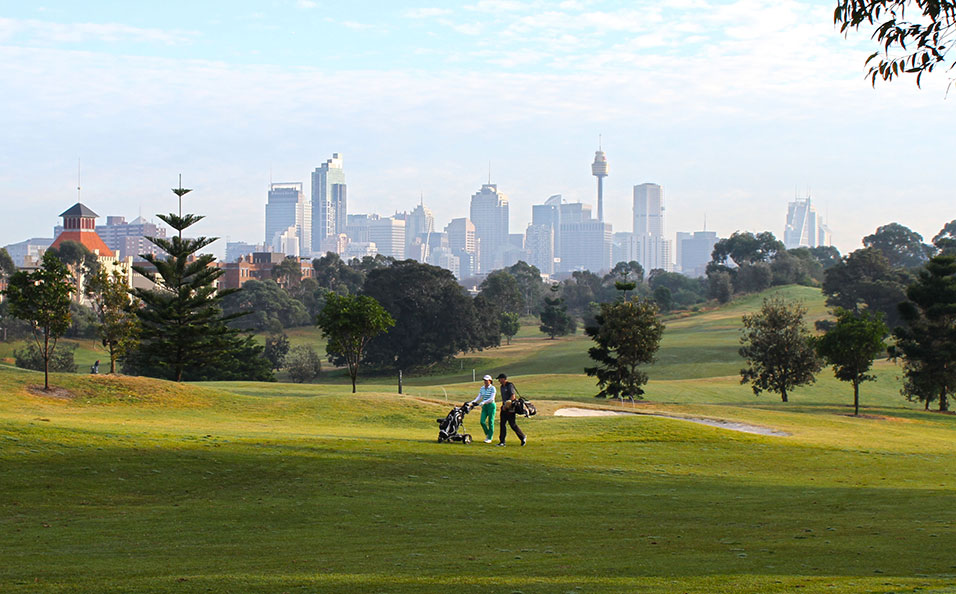Australia’s greatest advocate for public golf, Melbourne-based club pro Sandy Jamieson passed on some sage advice recently.
“As golfers, we must not get angry. We must get proactive,” Jamieson said in relation to public golf’s current fight for survival against land-swallowing councils. “Anger will be thrown straight back at us, and it will make us look entitled.”
With those wise words front of mind, here’s a measured take – no, really – on an unfortunate situation that’s being made even more unfortunate by the wild misinformation and political point scoring engulfing it.
Despite bringing in more than half a million people every year, Sydney’s Moore Park Golf Course will soon be cut in half after a years-long battle with council. Recently confirmed by New South Wales Premier Chris Minns along with Sydney Lord Mayor Clover Moore, nine of Moore Park Golf’s 18 holes will be seized by local government in order to build another park in Sydney by mid-2026.
The repurposing of 20 hectares is due to population growth near the course and tighter recreation budgets for new families. The park will sit not far from the immense urban renewal project three kilometres away at Green Square. I know. The irony, right? Green Square isn’t “green” enough… talk about putting the cart before the horse.
How adding another 80,000-odd people to an area already filled to the brim with congestion is beyond me but I’m not qualified to comment on matters pertaining to town planning, just like the vast majority of non-golfers – including most in NSW cabinet – don’t know and haven’t taken the time to understand the true extent of what public golf facilities like Moore Park offer the wider community.
I mean, even polarising former Victorian Premier Daniel Andrews can’t make sense of it all. “The notion that it’s either Moore Park as an 18-hole golf course or more housing, I don’t see how a park gets you more housing. It doesn’t,” Andrews told The State of the Game podcast.
“It means you get less golf and a golfing community that’s pretty upset. And I know a thing or two about upsetting a golf community but, in any event, my motives might have been a little purer than these.”
So, what are the motives behind Moore Park’s downsizing? The real motives, I mean. If catering for this newfound population is indeed the aim here – a legitimate concern – surely the repurposed land is better used for more high-density housing, as opposed to more parkland?
It’s a housing crisis we’re facing, not an open-space crisis, right? If by some chance it is the latter, isn’t the nearby Centennial Park, all 189 hectares of it, enough to cater for this predicted surge in picnic rugs?
It’s all very confusing.
Even Premier Minns himself came unstuck during a recent interview with 2GB’s Ben Fordham. When asked whether Sydney Lord Mayor Clover Moore had been lobbying him to downsize Moore Park amid backlash from local Sydneysiders, Minns had this to say: “I don’t think I’ve spoken to her directly about it at all”, which Fordham later revealed was not true after the Premier’s office had contacted the radio station to issue a correction.
“Chris Minns has been in contact with us off air and he wants to correct something he said in the interview,” Fordham later told listeners. “He’s (Premier) had a re-think…and he now says he did have a conversation with Clover Moore about it, apparently she raised it with Mr Minns a number of months ago.”
Deary me. As fellow shock jock Ray Hadley barked, it just doesn’t pass the pub test, Premier.

Premier of New South Wales, Chris Minns [Photo: Mark Evans]
Anyway, back to what I’m qualified to comment on – the golf side of this debacle. Here’s a quick fact check on Moore Park Golf Course:
• Of the more than 500,000 people who utilise Moore Park each year, 82 percent live within 10kms, while 18-hole rounds account for 80 percent of the 90,824 annual total.
• Sydney Golf Academy’s 27,418 students (2022/23) represents a 78 percent increase from 2019 and introductory groups have 74 percent higher women’s enrolments.
• The majority of Moore Park users walk 18 holes, with more than 302,840kms walked/121,136 calories burnt per annum at the facility, supporting studies showing golfers live longer, golf helps with chronic diseases and improves balance and muscle endurance.
• Golf provides $527 million of economic benefit to the Sydney Metropolitan Area annually, with green fees and membership at Moore Park alone totalling $3.2 million (ex GST) per annum.
• In addition to welcoming golfers of all ages, Moore Park hosted 555 corporate and charity events last financial year and 25 percent of total users are aged 18-35.
• Moore Park provides urban cooling, flood and stormwater management, water filtration and purification and carbon sequestration, enahnced by environmentally focused practices by Centennial Parklands Greens & Course Maintenance.
The Lord Mayor said that the club and driving range will not be touched and the nine-hole course isn’t going anywhere anytime soon. That’s a relief, but here’s a question that needs answering: what happens with the remaining facility? Is anyone willing to “chip in” to transform what’s left of Moore Park Golf into an even better community asset? Will planning approvals include a proviso to invest back into the chopped-up course that, frankly, could be one of the better short courses in the country with a little bit of vision? Happy community, happy golfers – everyone stands to win here, particularly Premier Minns. And yet nothing, zilch, not a word.

While Premier Minns reassured us that no other public courses were in the firing line, it’s a commitment that should be considered anything but iron clad. I mean, how can it be? If a government is prepared to slice and dice one of the world’s busiest publicly accessible golf courses – not an ultra-private club for “rich, white males” as has been the repeated line in recent weeks – what’s going to stop them from targeting your local club next?
Editor’s note for other (tabloid) editors: rich, white men don’t frequent Moore Park Golf Course – they play up the road at the various private clubs that command upwards of $50,000 to join and offer grill rooms and wine cellars, not pie warmers. See the difference?
Sadly, golf’s take on this controversy may all be in vain, regardless of how measured it is. Sources tell us the Moore Park decision is final, and the wheels are already in motion. Similar decisions could become the new norm, too, simply because the public land these courses sit on has become far too valuable, for both redevelopment and votes. A bigger Australia means a smaller footprint for golf, folks. Enjoy that round you’re playing today.
But have we, as a sport, contributed to this escalating mess? Potentially. Here are some questions golf must ask of itself:
1. Have we become too emotionally attached to the concept of losing 18 holes? In Moore Park’s case, would a reinvigorated nine-hole facility with driving range/mini golf still scratch the itch of those who use the current facility? Would playing two loops of the same nine – albeit a much better nine after a redesign – really drive members away? Would a new-look Moore Park short course, potentially ranked in Australia’s Top 100 Courses, be a better outcome for all and sundry?
2. Can neighbouring private clubs do more to help public courses under attack? Jamieson thinks so. “I would love to see some of the private clubs step in and help because, at the end of the day, they’re the ultimate beneficiaries of public golf courses,” he says. “Out of every 10 people I introduce to golf, two of them will go on to join a private golf club. It would be incredibly disappointing if these private clubs didn’t get together and start looking after their local public golf courses – even work with councils on how they can help in some way, shape or form.”
One only needs to look at the Royal Melbourne-Sandy Golf Links collaboration to see what can be achieved when private and public courses come together as one.
3. I don’t envy them one bit given the predicament they’re in, but can the sport’s governing bodies really afford to question – let alone vehemently reject – the NSW Government’s plans for Moore Park while said government is funding their marquee professional tournament down the road? Here was their attempt in a press release earlier this week: “Golf Australia welcomes the opportunity to work with Golf New South Wales and the NSW Government on the future of Moore Park Golf Course and the broader facility in central Sydney. As part of the planned consultation process with the NSW Government, and with Golf NSW as the team on the ground in the region with experience in previous discussions regarding Moore Park’s future configuration, the environmental benefits of golf will be a key focal point.”
Sigh. I haven’t felt this deflated since that gut-wrenching Sunday afternoon at the 1996 Masters.
That’s sport and politics for you.
4. Are public courses open to sharing their land for public use outside traditional golf hours? If it’s the difference between remaining untouched or losing some or all of their holes, would golf clubs welcome the wider community with open arms to utilise their fairways for exercise, picnics, dog walking and various other recreational pursuits on Sundays or even daily before, say, 8am and after 4pm? The famous Old Course at St Andrews has had it worked out for centuries. No fences, no rules, no golf on Sundays. By doing so it leaves no questions from anybody – questions we just know will continue to be asked here in Australia if we don’t start to mutually give and take.
• What do you think of the ongoing threat to public golf courses in Australia? E-mail me your thoughts to [email protected]



